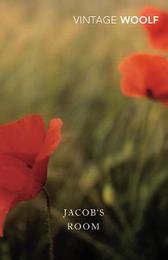
|
Jacob's Room
Paperback / softback
Main Details
| Title |
Jacob's Room
|
| Authors and Contributors |
By (author) Virginia Woolf
|
| Physical Properties |
| Format:Paperback / softback | | Pages:208 | | Dimensions(mm): Height 198,Width 129 |
|
| Category/Genre | Modern and contemporary fiction (post c 1945) |
|---|
| ISBN/Barcode |
9780099478263
|
| Classifications | Dewey:823.912 |
|---|
| Audience | |
|---|
|
Publishing Details |
| Publisher |
Vintage Publishing
|
| Imprint |
Vintage Classics
|
| Publication Date |
2 December 2004 |
| Publication Country |
United Kingdom
|
Description
Jacob's Room is Virgina Woolf's first truly experimental novel. It is a portrait of a young man, who is both representative and victim of the social values which led Edwardian society into war. Jacob's life is traced from childhood, life at Cambridge University to his early adult life in artistic London. Jacob consistently yearns for something greater and, in an attempt to resuscitate his love of the classics, he embarks on a voyage to the Mediterranean before the begins and his fate is forever altered. In 1922 E. M. Forster wrote of Jacob's Room, 'amazing...a new type of fiction has swum into view'. Impressionistic in style, experimental in approach, this narrative is as inspired now as it was when it first appeared.
Author Biography
Virginia Woolf was born in London in 1882, the daughter of Sir Leslie Stephen, first editor of The Dictionary of National Biography. After his death in 1904 Virginia and her sister, the painter Vanessa Bell, moved to Bloomsbury and became the centre of 'The Bloomsbury Group'. This informal collective of artists and writers which included Lytton Strachey and Roger Fry, exerted a powerful influence over early twentieth-century British culture. In 1912 Virginia married Leonard Woolf, a writer and social reformer. Three years later, her first novel The Voyage Out was published, followed by Night and Day (1919) and Jacob's Room (1922). These first novels show the development of Virginia Woolf's distinctive and innovative narrative style. It was during this time that she and Leonard Woolf founded The Hogarth Press with the publication of the co-authored Two Stories in 1917, hand-printed in the dining room of their house in Surrey. Between 1925 and 1931 Virginia Woolf produced what are now regarded as her finest masterpieces, from Mrs Dalloway (1925) to the poetic and highly experimental novel The Waves (1931). She also maintained an astonishing output of literary criticism, short fiction, journalism and biography, including the playfully subversive Orlando (1928) and A Room of One's Own (1929) a passionate feminist essay. This intense creative productivity was often matched by periods of mental illness, from which she had suffered since her mother's death in 1895. On 28 March 1941, a few months before the publication of her final novel, Between the Acts, Virginia Woolf committed suicide.
ReviewsJacob, of whom people speak, of whom they think, but who is never shown. And yet that denial of presence on the part of the author makes of him one of the most living presences in world literature. It's a remarkable achievement. * New Statesman * Virginia Woolf stands as the chief figure of modernism in England and must be included with Joyce and Proust in the realisation of experimental achievements that have completely broken with tradition * New York Times *
|